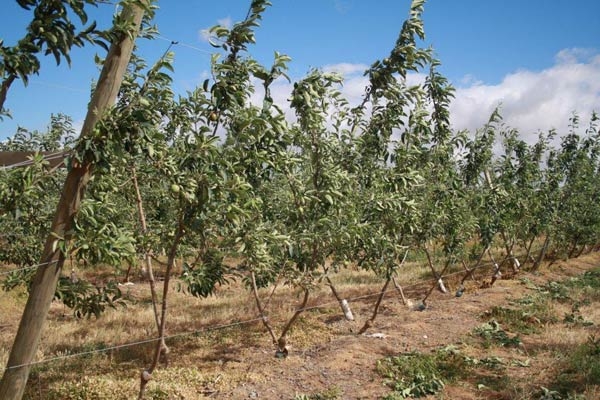A trend is developing in the Goulburn Valley, Victoria, in the training of young apple trees that does not make horticultural sense—and is contrary to the basic principles and practices of training and pruning apple trees on the Tatura systems.
Another worry is that orchardists often copy each other’s practices without questioning the merits.
The goal of any new trellised high-density planting is to make a profit. These days this is a challenge given the high initial investment required, a period of negative cash flow which follows, and the escalating production costs relative to returns.
Such an economic environment makes it critically important to manage young orchards in order to realise a net profit as soon as possible.
Such management includes the early promotion of marketable fruit, and continuing each year throughout the life of the orchard.
Care must be taken that management and production practices used to develop the young orchard are cost-effective, otherwise early yields may not translate into early profits.
Common cultural practices
A wide array of cultural practices is used in development of an orchard, each modified by management characteristics of specific training systems.
However, regardless of cultural and management practices, there are certain basic principles of training and pruning that are common to any system. Such commonality is because the training and pruning effects are governed by certain biological principles of growth and fruiting.
How to get a newly-planted orchard quickly into production
Sunlight is the key
Sunlight interception by fruit trees is the single most important factor determining orchard productivity and therefore is a critical factor in the design of an orchard system.
An orchard should intercept about 70 per cent of the sunlight striking the trees as early in their lives as possible. This means that only 30 per cent of sunlight is allowed to strike the orchard floor (and thus is wasted), but this is necessary for access to the trees.
The high proportion of sunlight striking (intercepting) fruit trees in an orchard is critical, because it is positively correlated with fruit production per hectare.
Young orchards with high light interception have higher yields than do young orchards with low light interception.
There are four ways to achieve high light interception in orchards with young trees:
- Plant between 2000 and 3000 trees per hectare
- Plant good quality 2-year-old trees
- Promote rapid, balanced and healthy growth of the tree’s structure. This can only be achieved if you firstly develop a tree framework of branches that are capable of quickly filling the allocated space on the trellis. Branches trained into the correct position will subsequently balance vegetative growth with adequate development of flower buds.
- Train more and prune less.
Poor or misunderstood practices
Some orchardists believe and/or have been advised, that shoots and branches of young apple trees forced down in a horizontal or below horizontal position, slow down vigour and increase early yields.
In addition, the 3-to-1 rule is ignored—branches of many thicknesses and lengths are retained.
Rapid development of a full canopy appears to be a secondary consideration. What happens to such shoots and branches is overlooked, or the responses to bending are not understood.
Bending is when a shoot or branch is curved with the tip facing down. Part of a horizontal shoot or branch may have a curve.
Spreading is extending the angle between 30 and 60 degrees to the vertical with the tip following the angle.
Shoots or new shoots refer to current growth up to one year. These shoots are long and vigorous and their tip buds often remain vegetative.
Branches are older than one year, and have formed laterals, spurs and new shoots.
Bending shoots & branches is not recommended for Australian conditions
Success in obtaining a sustainable long term optimum production of apples of high quality in countries like Australia—with long hot summers— is unlikely when shoots and branches are forced to grow horizontally or below horizontal to control vigour and increase precocity.
Bending works in cool climates
Such training can succeed in countries with cool climates. That is, if the day temperature does not exceed 20C and the night temperature is around 16C, the upright regrowth is relatively limited and sunburnt fruit is not a problem.
However, if the day temperature is in the 30C range and the night temperature exceeds 25C, the regrowth is too strong and the risk of causing fruit to sunburn is high in systems such as Tatura Trellis, Open Tatura, Slender Spindle and Central Leader—even with apple trees on M9 or M26 rootstock.
Spreading works in warm regions
Shoots and branches of young apple trees are not bent in the Western Cape province of South Africa, which has a similar climate to the warm temperate regions of southern mainland Australia.
Spreading is widely used in South Africa and often starts with toothpicks.
Effects of bending
Hormones
Bending changes the hormonal makeup of the shoot or branch, and this can sometimes create a desirable effect, but can also cause problems.
The orientation of a shoot or branch affects apical dominance. Apical dominance results from the interaction of four plant hormones: auxin, cytokinin, gibberellic acid and abscisic acid.
Auxin
(Continues next month)
For an excellent selection of photos with this article, see Tree Fruit March 2013






















